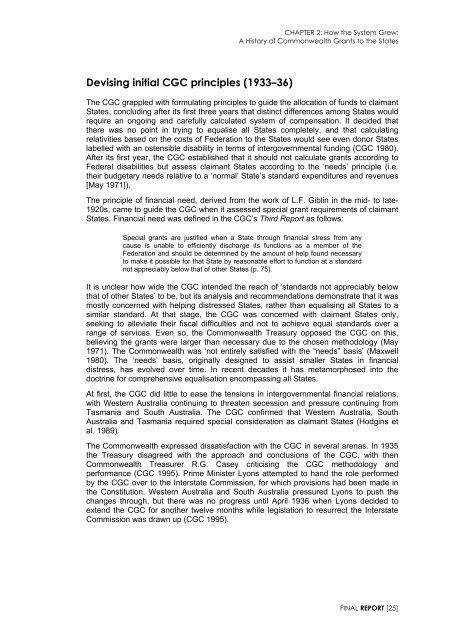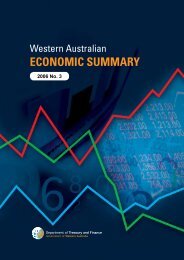Garnaut Fitzgerald Review of Commonwealth-State Funding
Garnaut Fitzgerald Review of Commonwealth-State Funding
Garnaut Fitzgerald Review of Commonwealth-State Funding
You also want an ePaper? Increase the reach of your titles
YUMPU automatically turns print PDFs into web optimized ePapers that Google loves.
CHAPTER 2: How the System Grew:<br />
A History <strong>of</strong> <strong>Commonwealth</strong> Grants to the <strong>State</strong>s<br />
Devising initial CGC principles (1933–36)<br />
The CGC grappled with formulating principles to guide the allocation <strong>of</strong> funds to claimant<br />
<strong>State</strong>s, concluding after its first three years that distinct differences among <strong>State</strong>s would<br />
require an ongoing and carefully calculated system <strong>of</strong> compensation. It decided that<br />
there was no point in trying to equalise all <strong>State</strong>s completely, and that calculating<br />
relativities based on the costs <strong>of</strong> Federation to the <strong>State</strong>s would see even donor <strong>State</strong>s<br />
labelled with an ostensible disability in terms <strong>of</strong> intergovernmental funding (CGC 1980).<br />
After its first year, the CGC established that it should not calculate grants according to<br />
Federal disabilities but assess claimant <strong>State</strong>s according to the ‘needs’ principle (i.e.<br />
their budgetary needs relative to a ‘normal’ <strong>State</strong>’s standard expenditures and revenues<br />
[May 1971]).<br />
The principle <strong>of</strong> financial need, derived from the work <strong>of</strong> L.F. Giblin in the mid- to late-<br />
1920s, came to guide the CGC when it assessed special grant requirements <strong>of</strong> claimant<br />
<strong>State</strong>s. Financial need was defined in the CGC’s Third Report as follows:<br />
Special grants are justified when a <strong>State</strong> through financial stress from any<br />
cause is unable to efficiently discharge its functions as a member <strong>of</strong> the<br />
Federation and should be determined by the amount <strong>of</strong> help found necessary<br />
to make it possible for that <strong>State</strong> by reasonable effort to function at a standard<br />
not appreciably below that <strong>of</strong> other <strong>State</strong>s (p. 75).<br />
It is unclear how wide the CGC intended the reach <strong>of</strong> ‘standards not appreciably below<br />
that <strong>of</strong> other <strong>State</strong>s’ to be, but its analysis and recommendations demonstrate that it was<br />
mostly concerned with helping distressed <strong>State</strong>s, rather than equalising all <strong>State</strong>s to a<br />
similar standard. At that stage, the CGC was concerned with claimant <strong>State</strong>s only,<br />
seeking to alleviate their fiscal difficulties and not to achieve equal standards over a<br />
range <strong>of</strong> services. Even so, the <strong>Commonwealth</strong> Treasury opposed the CGC on this,<br />
believing the grants were larger than necessary due to the chosen methodology (May<br />
1971). The <strong>Commonwealth</strong> was ‘not entirely satisfied with the “needs” basis’ (Maxwell<br />
1980). The ‘needs’ basis, originally designed to assist smaller <strong>State</strong>s in financial<br />
distress, has evolved over time. In recent decades it has metamorphosed into the<br />
doctrine for comprehensive equalisation encompassing all <strong>State</strong>s.<br />
At first, the CGC did little to ease the tensions in intergovernmental financial relations,<br />
with Western Australia continuing to threaten secession and pressure continuing from<br />
Tasmania and South Australia. The CGC confirmed that Western Australia, South<br />
Australia and Tasmania required special consideration as claimant <strong>State</strong>s (Hodgins et<br />
al. 1989).<br />
The <strong>Commonwealth</strong> expressed dissatisfaction with the CGC in several arenas. In 1935<br />
the Treasury disagreed with the approach and conclusions <strong>of</strong> the CGC, with then<br />
<strong>Commonwealth</strong> Treasurer R.G. Casey criticising the CGC methodology and<br />
performance (CGC 1995). Prime Minister Lyons attempted to hand the role performed<br />
by the CGC over to the Interstate Commission, for which provisions had been made in<br />
the Constitution. Western Australia and South Australia pressured Lyons to push the<br />
changes through, but there was no progress until April 1936 when Lyons decided to<br />
extend the CGC for another twelve months while legislation to resurrect the Interstate<br />
Commission was drawn up (CGC 1995).<br />
FINAL REPORT [25]

















